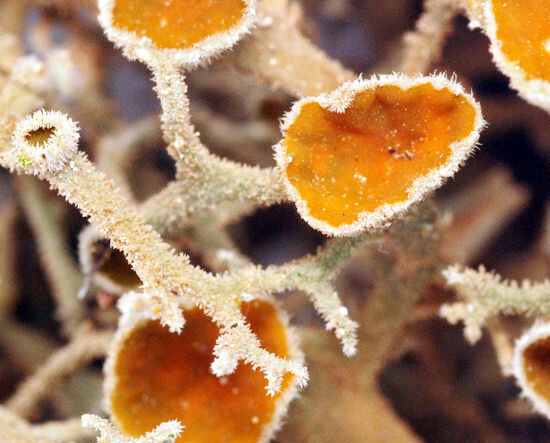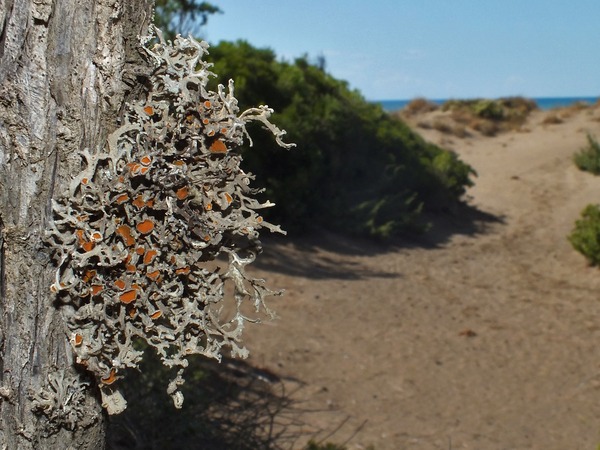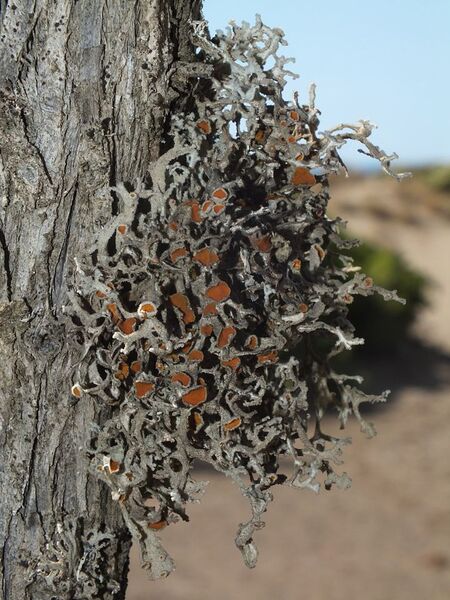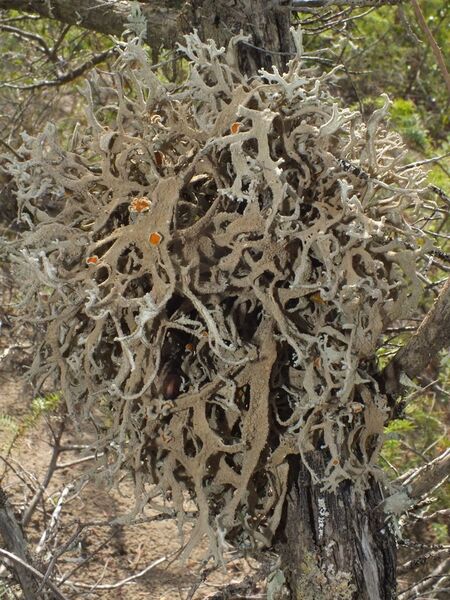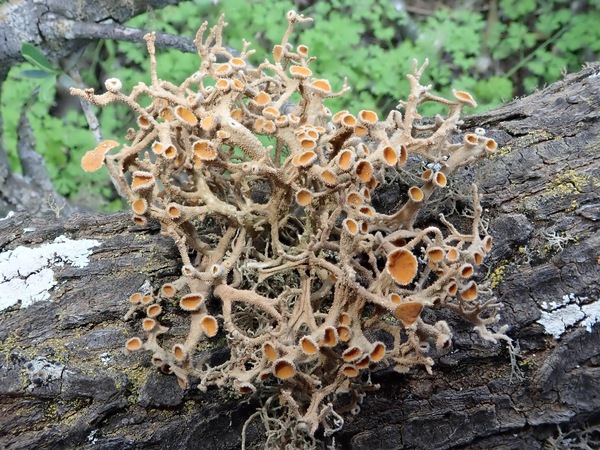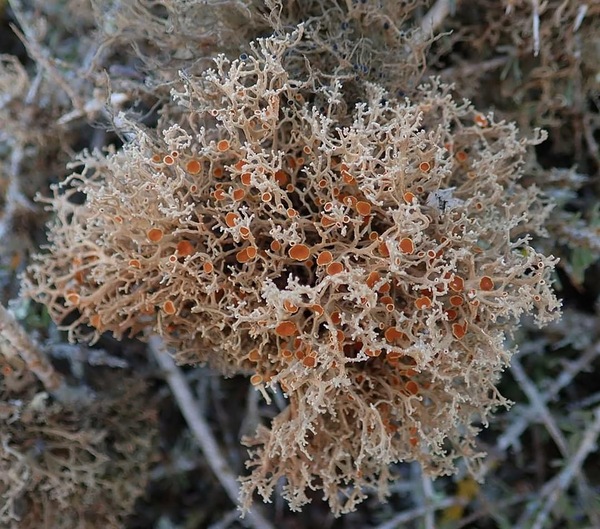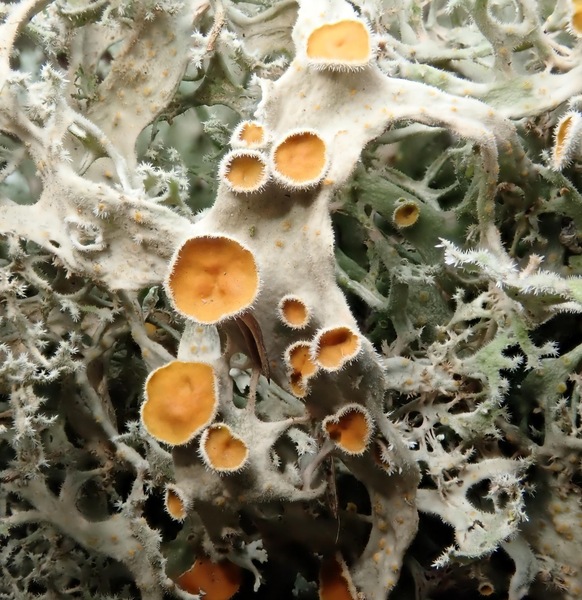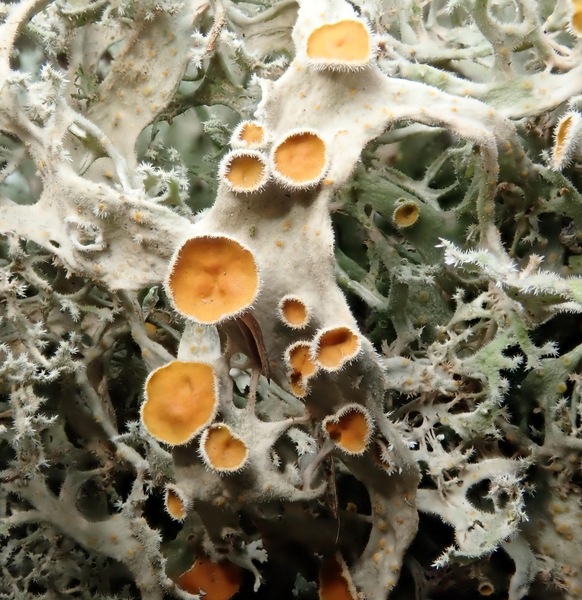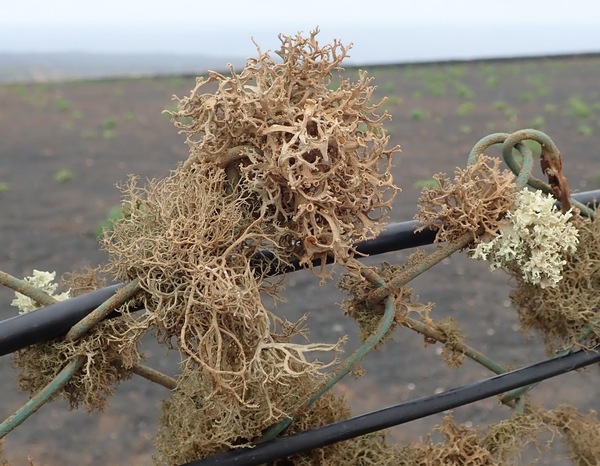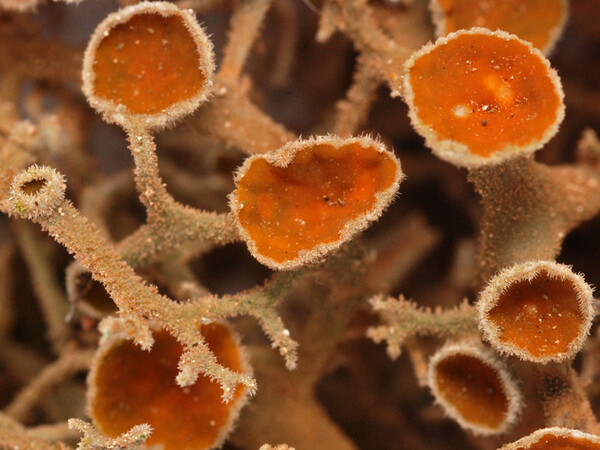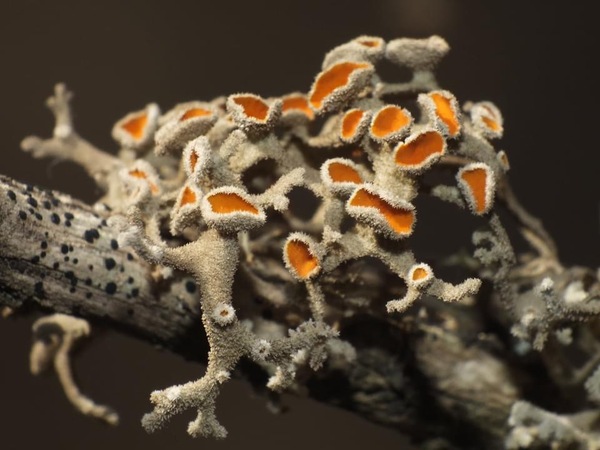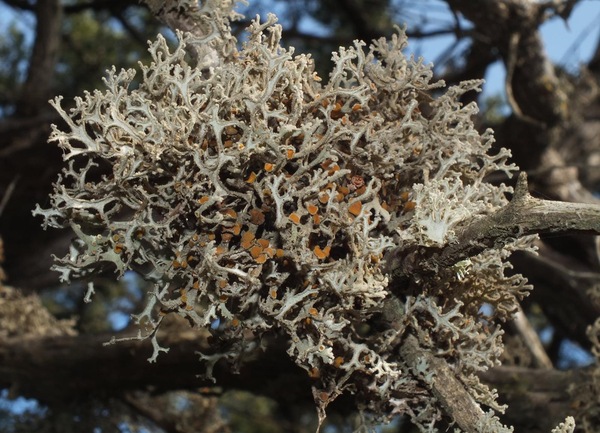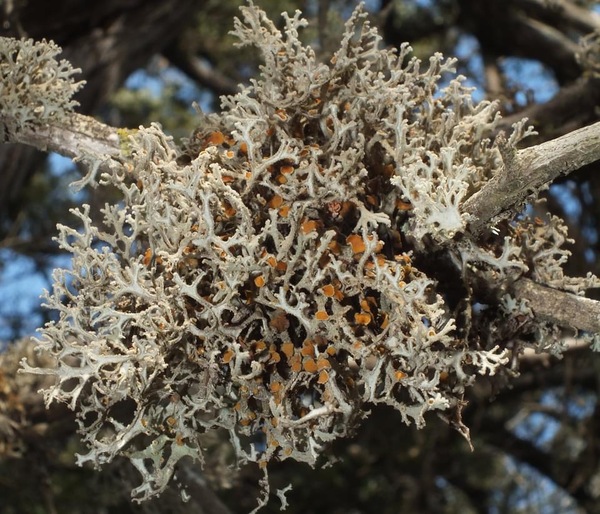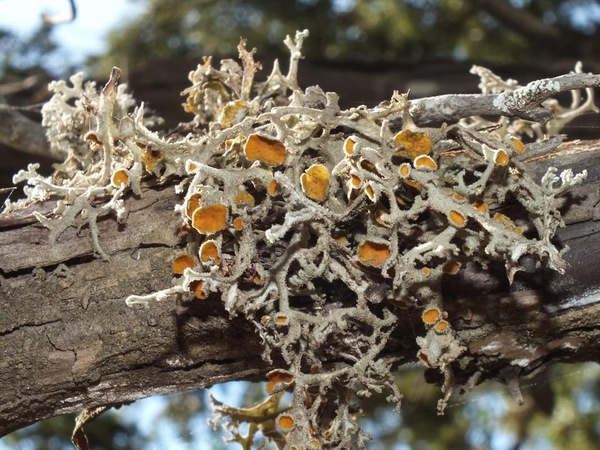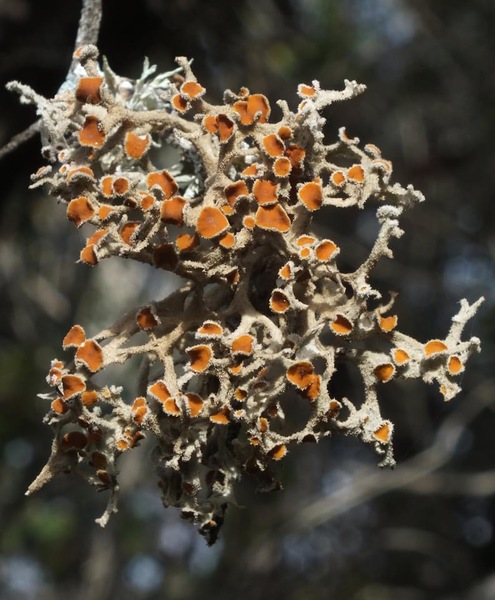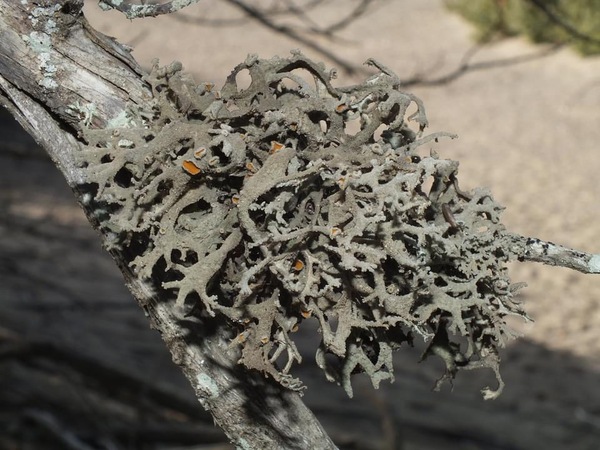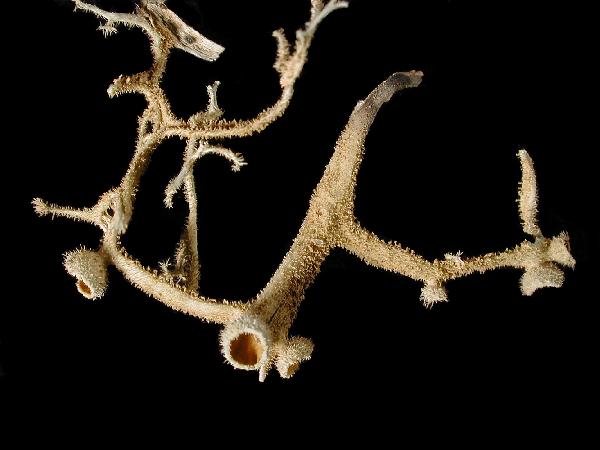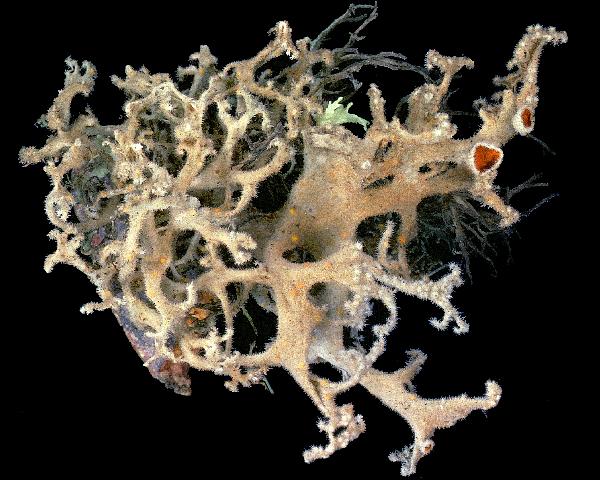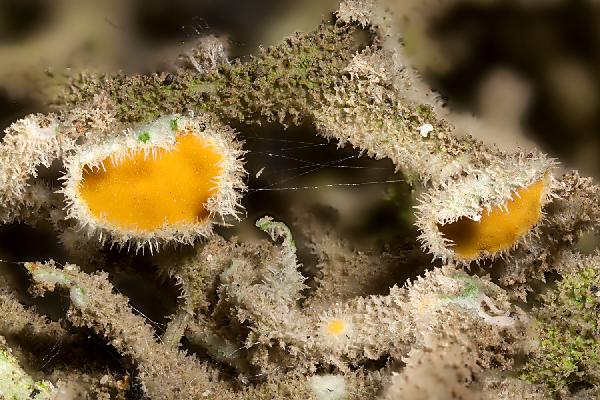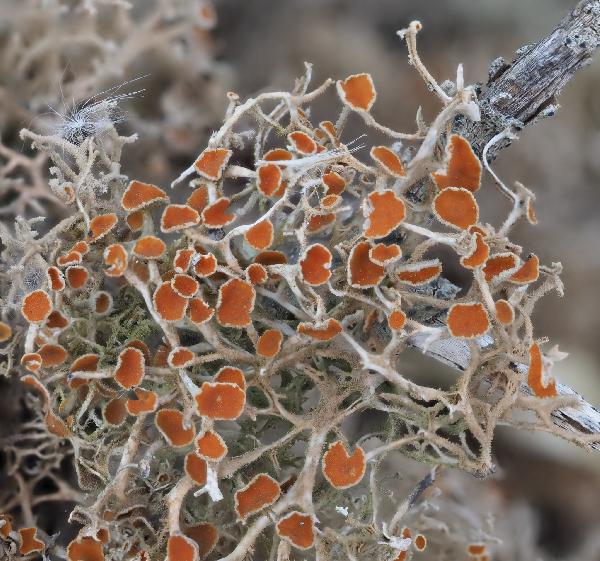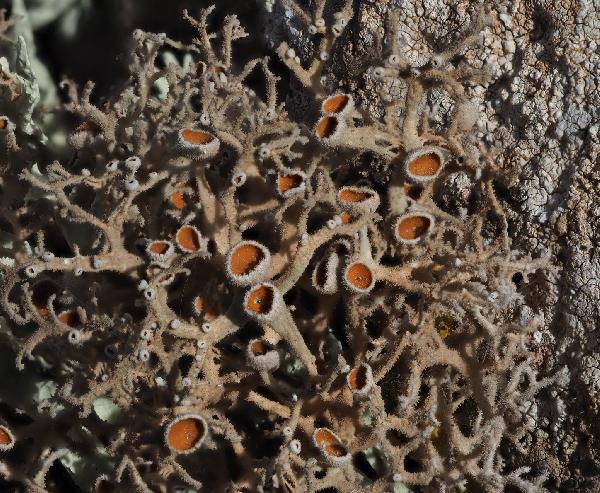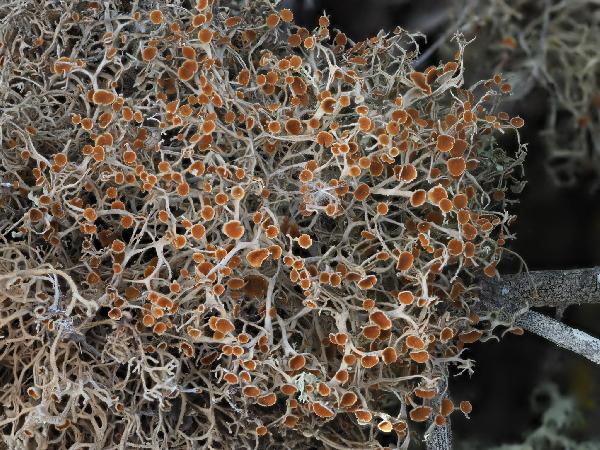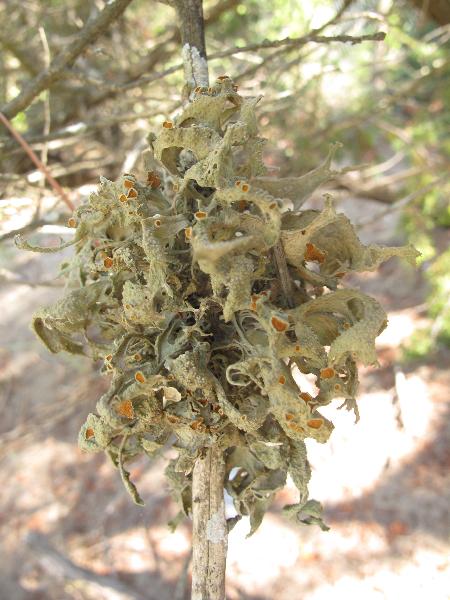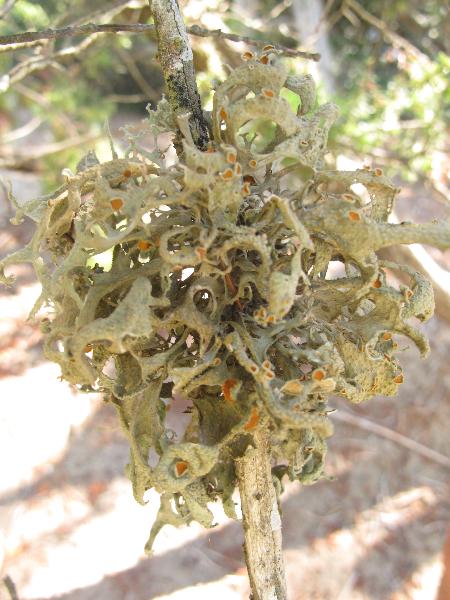Seirophora villosa (Ach.) Frödén
in Frödén & Lassen, Lichenologist, 36: 297, 2004. Basionym: Parmelia villosa Ach. - Meth. Lich.: 254, 1803.
Synonyms: Physcia magara Kremp.; Physcia villosa f. brevior Nyl.; Physcia villosa var. calvescens De Not.; Seirophora magara (Kremp.) Poelt; Teloschistes brevior (Nyl.) Hillmann; Teloschistes villosus (Ach.) Norman
Distribution: C - Tosc (Putortì & Loppi 1999, Benesperi & Ravera 2011, Munzi & al. 2011, Benesperi & al. 2013, Watson 2014, Giordani & al. 2015, Brackel 2015, 2025, Lich. Ital. Exs. 7: Puntillo & al. 2017, Bianchi & al. 2019), Laz (Lich. Graec. 40: Obermayer 1995b, Benesperi & Ravera 2011, Lich. Graec. 498: Obermayer 2019), Sar (Salvà & al. 2009, 2010a, 2010b, Benesperi & Ravera 2011). S - Camp (Benesperi & Ravera 2011, Catalano & Aprile 2011, Catalano & al. 2012), Si (Benesperi & Ravera 2011).
Description: Thallus fruticose, attached by a basal holdfast, consisting of strap-shaped, flattened, dichotomously branched lobes forming dense, up to 15 cm wide and tall tufts. Lobes (2-)5-8(-10) mm wide in lower part, narrower in apical parts, finely tomentose, brownish, with a more or less canaliculate, often reticulately ridged lower surface. Cortex strongly conglutinated after treatment with K, 3-7 µm thick, of thick-walled cells. Apothecia common and usually abundant, lecanorine, slightly stipitate, with an orange, 2-7(-10) mm wide disc and a grey or brownish, thick thalline margin covered in short, fine white hairs. Epithecium orange-brown, K+ purple-red; hymenium and hypothecium colourless. Asci 8-spored, clavate, functionally unitunicate, apically thickened with a broad internal beak, the inner part of apex and external cap I+ blue, Teloschistes-type. Ascospores 2-celled, polarilocular, hyaline, ellipsoid, 10-15 x 5-7 µm, the equatorial thickening (“septum”) (1.5-)2-3(-4) µm. Pycnidia common, orange, c. 0.1-0.2 mm diam. Conidia bacilliform to narrowly ellipsoid, 3-4 x 1.5-1.7 µm. Photobiont: chlorococcoid. Spot test: thallus K-, C-, KC-, P-; disc of apothecia and pycnidia K+ purple-red. Chemistry: apothecia and pycnidia with parietin (major), fallacinal, teloschistin, and parietinic acid (all minor), and emodin (minor). Note: on twigs of shrubs and small trees subject to spells of dry situations and frequent humid maritime winds; presently restricted to a few natural sites of Tyrrhenian Italy, on almost undisturbed sand dunes. It is included in the Italian red list of epiphytic lichens as “Endangered” (Nascimbene & al. 2013c).
Growth form: Fruticose
Substrata: bark
Photobiont: green algae other than Trentepohlia
Reproductive strategy: mainly sexual
Taxon bound to maritime-coastal situations
Commonnes-rarity: (info)
Alpine belt: absent
Subalpine belt: absent
Oromediterranean belt: absent
Montane belt: absent
Submediterranean belt: absent
Padanian area: absent
Humid submediterranean belt: absent
Humid mediterranean belt: extremely rare
Dry mediterranean belt: absent
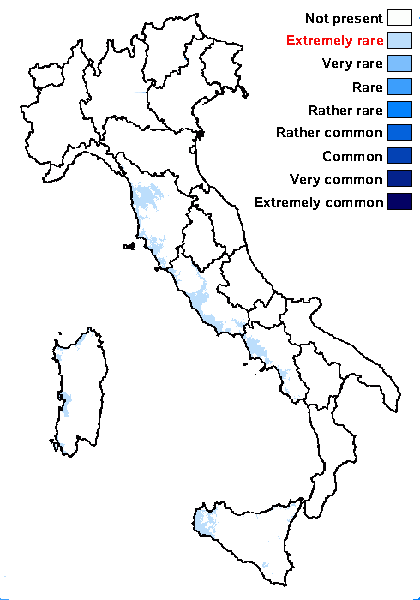
Predictive model
Herbarium samples
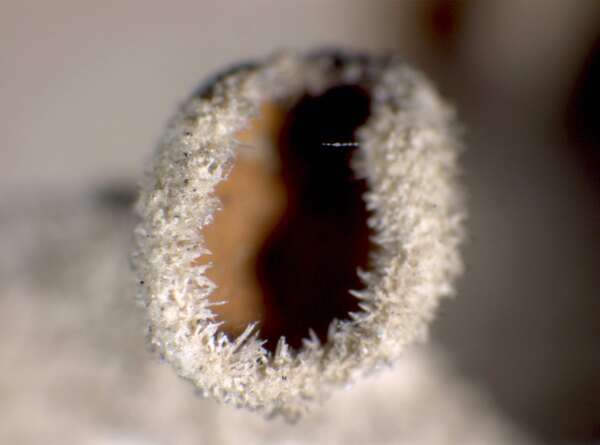

P.L. Nimis; Owner: Department of Life Sciences, University of Trieste
Herbarium: TSB (4165)
2001/12/03
detail of hairs on the apothecial margin
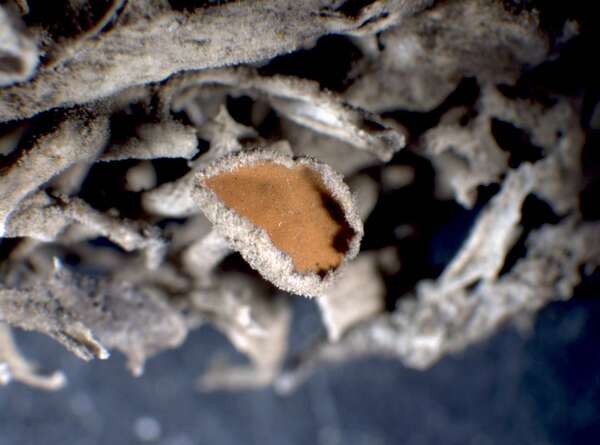

P.L. Nimis; Owner: Department of Life Sciences, University of Trieste
Herbarium: TSB (4165)
2001/12/03
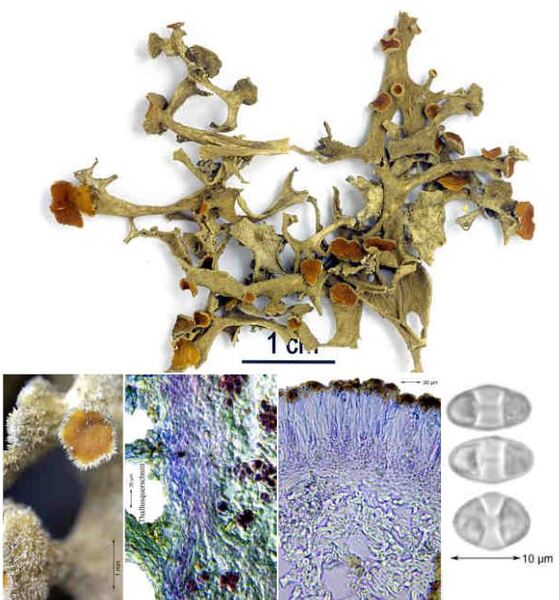

Felix Schumm – CC BY-SA 4.0
Image from: F. Schumm (2008) - Flechten Madeiras, der Kanaren und Azoren. Beck, OHG - ISBN: 978-3-00-023700-3

Courtesy Danièle et Olivier Gonnet - Source: https://www.afl-lichenologie.fr/Photos_AFL/Photos_AFL_S/Text_S2/Seirophora_villosa.htm
France, 3/10/2014 - Vers les Ruines de Piantarella bord côtier, alt. 10 m - Corse
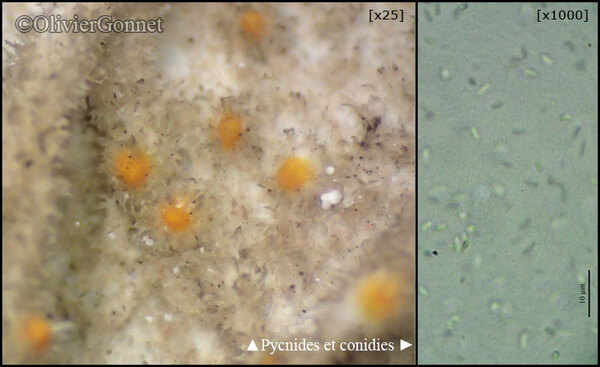
Courtesy Danièle et Olivier Gonnet - Source: https://www.afl-lichenologie.fr/Photos_AFL/Photos_AFL_S/Text_S2/Seirophora_villosa.htm
France, 3/10/2014 - Vers les Ruines de Piantarella bord côtier, alt. 10 m - Corse
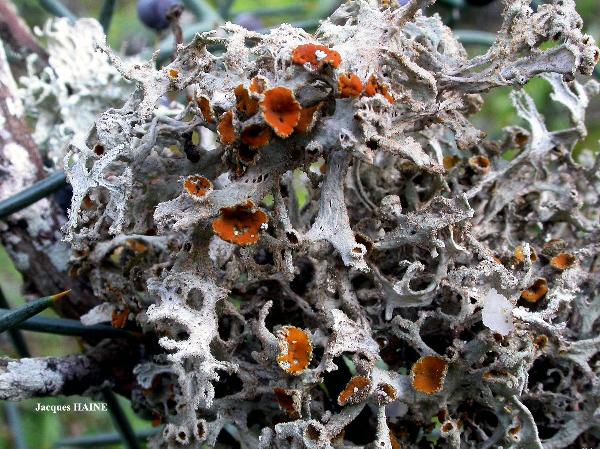
Jacques Haine - Source: http://www.lichensmaritimes.org/index.php?task=fiche&lichen=1062&lang=en
Spain, Islas Baleares, Mallorca
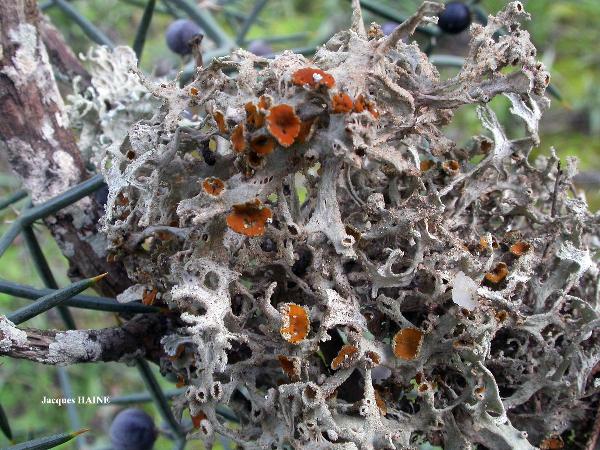
Jacques Haine - Source: http://www.lichensmaritimes.org/index.php?task=fiche&lichen=1062&lang=en
Spain, Islas Baleares, Mallorca
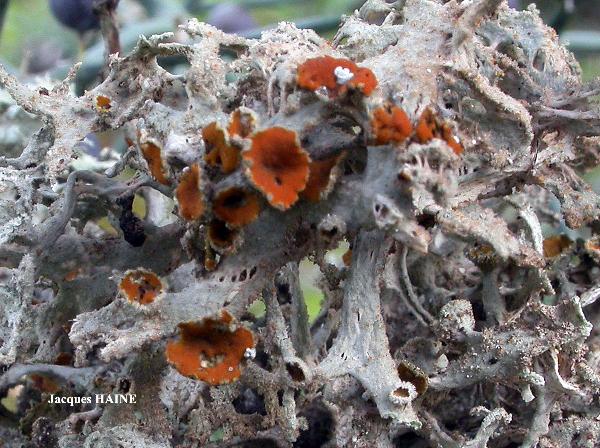
Jacques Haine - Source: http://www.lichensmaritimes.org/index.php?task=fiche&lichen=1062&lang=en
Spain, Islas Baleares, Mallorca
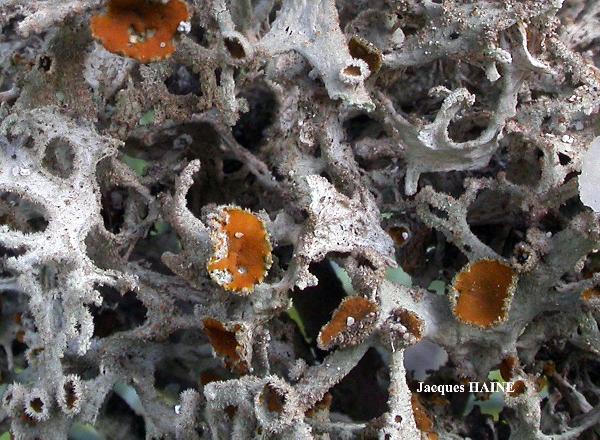
Jacques Haine - Source: http://www.lichensmaritimes.org/index.php?task=fiche&lichen=1062&lang=en
Spain, Islas Baleares, Mallorca
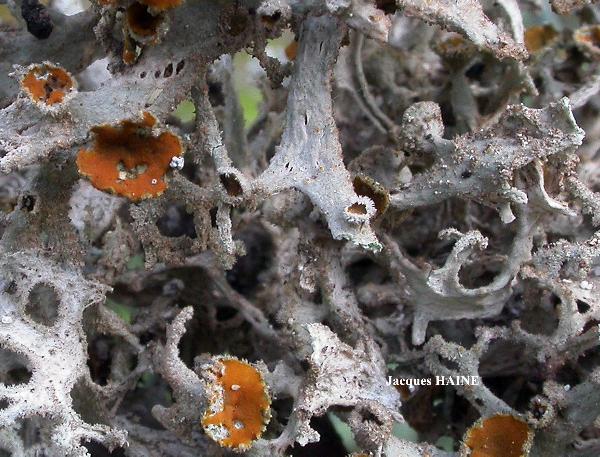
Jacques Haine - Source: http://www.lichensmaritimes.org/index.php?task=fiche&lichen=1062&lang=en
Spain, Islas Baleares, Mallorca


Juri Nascimbene & Pier Luigi Nimis
Italy, Lazio, Roma, Tenuta Presidenziale di Castelporziano
27.06.2024
on Juniperus and Phillyrea, coastal sand dunes
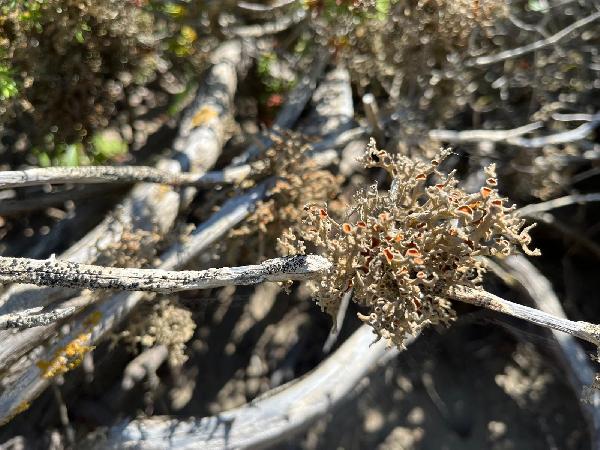

Juri Nascimbene & Pier Luigi Nimis
Italy, Lazio, Roma, Tenuta Presidenziale di Castelporziano
27.06.2024
on Juniperus and Phillyrea, coastal sand dunes
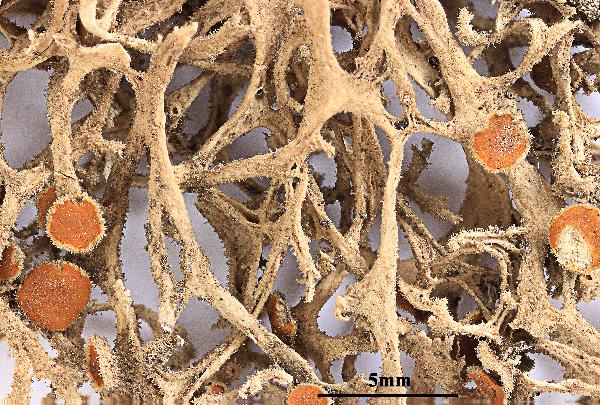

Felix Schumm - CC BY 4.0
[14326], Spain: Andalucia, Provincia de Almeria, coastal strip of the
Llanos de Almería, on fairly protected portions of branches and truncs
of Juniperus phoenicea and Pistacia lentiscus L.covering the largely
stabilized ridges of higher dunes between Playa de Cerillos and Punta
del Sabinal, not rarely asociated with Dirina ceratoniae (avh.) E. M.
Fries and Tornabea scutellifera (With.) Laund., 10-20 m, SE-SW exposition,
gregaruous, leg. et det. G. Follmann, 05.1988. EX G. FOLLMANN:
LICHENES EXSICCATI SELECTI AB INSTITUTO BOTANICO
UNIVERSITATIS COLONIENSIS EDITI NR. 495


Felix Schumm - CC BY 4.0
[14326], Spain: Andalucia, Provincia de Almeria, coastal strip of the
Llanos de Almería, on fairly protected portions of branches and truncs
of Juniperus phoenicea and Pistacia lentiscus L.covering the largely
stabilized ridges of higher dunes between Playa de Cerillos and Punta
del Sabinal, not rarely asociated with Dirina ceratoniae (avh.) E. M.
Fries and Tornabea scutellifera (With.) Laund., 10-20 m, SE-SW exposition,
gregaruous, leg. et det. G. Follmann, 05.1988. EX G. FOLLMANN:
LICHENES EXSICCATI SELECTI AB INSTITUTO BOTANICO
UNIVERSITATIS COLONIENSIS EDITI NR. 495
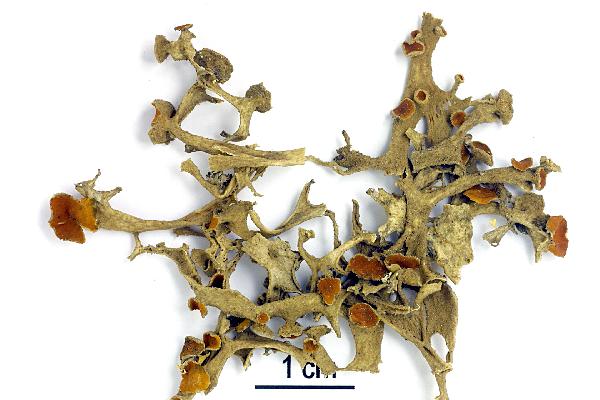

Felix Schumm - CC BY 4.0
[812020], Spanien: Andalucía, Provincia de Almería, coastal strip of the
Llanos de Almería, on fairly protected portions of branches and trunks
of Juniperus phoenica and Pistacia lentiscus between Playa de Cerillos
and Punta del Sabinal, 10-20 m. Leg. G. Follmann, 05.1988, det. G.
Follmann. EX G. FOLLMANN: LICHENES EXSICCATI SELECTI AB INSTITUTO
BOTANICO UNIVERSITATIS COLONIENSIS EDITI NR. 495. - associated
with Dirina ceratoniae and Tornabea scutellifera
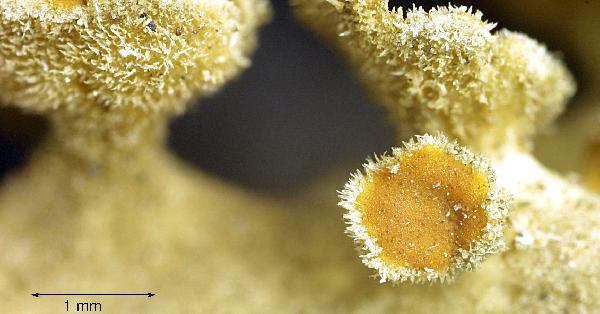

Felix Schumm - CC BY 4.0
[812020], Spanien: Andalucía, Provincia de Almería, coastal strip of the
Llanos de Almería, on fairly protected portions of branches and trunks
of Juniperus phoenica and Pistacia lentiscus between Playa de Cerillos
and Punta del Sabinal, 10-20 m. Leg. G. Follmann, 05.1988, det. G.
Follmann. EX G. FOLLMANN: LICHENES EXSICCATI SELECTI AB INSTITUTO
BOTANICO UNIVERSITATIS COLONIENSIS EDITI NR. 495. - associated
with Dirina ceratoniae and Tornabea scutellifera
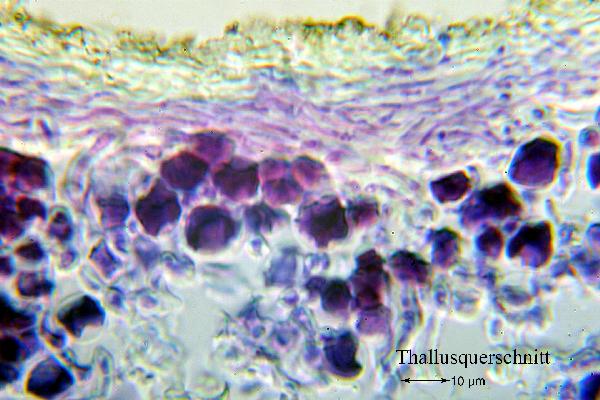

Felix Schumm - CC BY 4.0
[812020], Spanien: Andalucía, Provincia de Almería, coastal strip of the
Llanos de Almería, on fairly protected portions of branches and trunks
of Juniperus phoenica and Pistacia lentiscus between Playa de Cerillos
and Punta del Sabinal, 10-20 m. Leg. G. Follmann, 05.1988, det. G.
Follmann. EX G. FOLLMANN: LICHENES EXSICCATI SELECTI AB INSTITUTO
BOTANICO UNIVERSITATIS COLONIENSIS EDITI NR. 495. - associated
with Dirina ceratoniae and Tornabea scutellifera
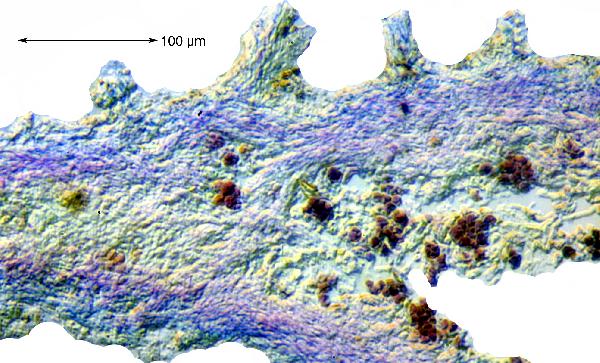

Felix Schumm - CC BY 4.0
[812020], Spanien: Andalucía, Provincia de Almería, coastal strip of the
Llanos de Almería, on fairly protected portions of branches and trunks
of Juniperus phoenica and Pistacia lentiscus between Playa de Cerillos
and Punta del Sabinal, 10-20 m. Leg. G. Follmann, 05.1988, det. G.
Follmann. EX G. FOLLMANN: LICHENES EXSICCATI SELECTI AB INSTITUTO
BOTANICO UNIVERSITATIS COLONIENSIS EDITI NR. 495. - associated
with Dirina ceratoniae and Tornabea scutellifera


Felix Schumm - CC BY 4.0
[812020], Spanien: Andalucía, Provincia de Almería, coastal strip of the
Llanos de Almería, on fairly protected portions of branches and trunks
of Juniperus phoenica and Pistacia lentiscus between Playa de Cerillos
and Punta del Sabinal, 10-20 m. Leg. G. Follmann, 05.1988, det. G.
Follmann. EX G. FOLLMANN: LICHENES EXSICCATI SELECTI AB INSTITUTO
BOTANICO UNIVERSITATIS COLONIENSIS EDITI NR. 495. - associated
with Dirina ceratoniae and Tornabea scutellifera


Felix Schumm - CC BY 4.0
[812020], Spanien: Andalucía, Provincia de Almería, coastal strip of the
Llanos de Almería, on fairly protected portions of branches and trunks
of Juniperus phoenica and Pistacia lentiscus between Playa de Cerillos
and Punta del Sabinal, 10-20 m. Leg. G. Follmann, 05.1988, det. G.
Follmann. EX G. FOLLMANN: LICHENES EXSICCATI SELECTI AB INSTITUTO
BOTANICO UNIVERSITATIS COLONIENSIS EDITI NR. 495. - associated
with Dirina ceratoniae and Tornabea scutellifera
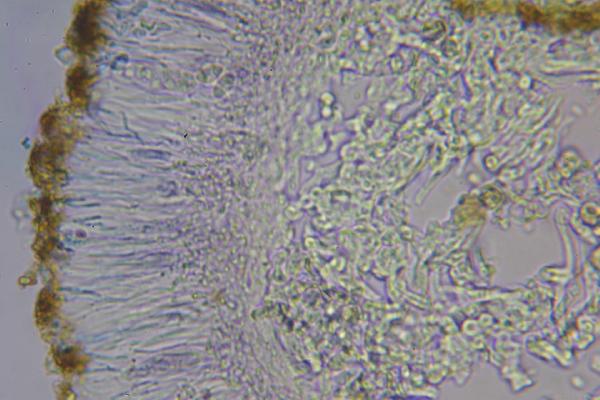

Felix Schumm - CC BY 4.0
[812020], Spanien: Andalucía, Provincia de Almería, coastal strip of the
Llanos de Almería, on fairly protected portions of branches and trunks
of Juniperus phoenica and Pistacia lentiscus between Playa de Cerillos
and Punta del Sabinal, 10-20 m. Leg. G. Follmann, 05.1988, det. G.
Follmann. EX G. FOLLMANN: LICHENES EXSICCATI SELECTI AB INSTITUTO
BOTANICO UNIVERSITATIS COLONIENSIS EDITI NR. 495. - associated
with Dirina ceratoniae and Tornabea scutellifera
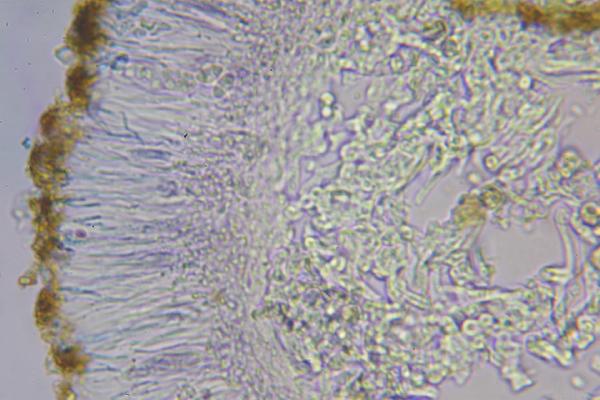

Felix Schumm - CC BY 4.0
[812020], Spanien: Andalucía, Provincia de Almería, coastal strip of the
Llanos de Almería, on fairly protected portions of branches and trunks
of Juniperus phoenica and Pistacia lentiscus between Playa de Cerillos
and Punta del Sabinal, 10-20 m. Leg. G. Follmann, 05.1988, det. G.
Follmann. EX G. FOLLMANN: LICHENES EXSICCATI SELECTI AB INSTITUTO
BOTANICO UNIVERSITATIS COLONIENSIS EDITI NR. 495. - associated
with Dirina ceratoniae and Tornabea scutellifera
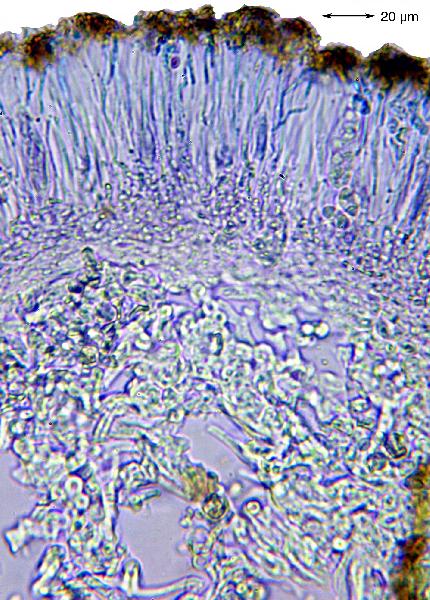

Felix Schumm - CC BY 4.0
[812020], Spanien: Andalucía, Provincia de Almería, coastal strip of the
Llanos de Almería, on fairly protected portions of branches and trunks
of Juniperus phoenica and Pistacia lentiscus between Playa de Cerillos
and Punta del Sabinal, 10-20 m. Leg. G. Follmann, 05.1988, det. G.
Follmann. EX G. FOLLMANN: LICHENES EXSICCATI SELECTI AB INSTITUTO
BOTANICO UNIVERSITATIS COLONIENSIS EDITI NR. 495. - associated
with Dirina ceratoniae and Tornabea scutellifera


Felix Schumm - CC BY 4.0
[812020], Spanien: Andalucía, Provincia de Almería, coastal strip of the
Llanos de Almería, on fairly protected portions of branches and trunks
of Juniperus phoenica and Pistacia lentiscus between Playa de Cerillos
and Punta del Sabinal, 10-20 m. Leg. G. Follmann, 05.1988, det. G.
Follmann. EX G. FOLLMANN: LICHENES EXSICCATI SELECTI AB INSTITUTO
BOTANICO UNIVERSITATIS COLONIENSIS EDITI NR. 495. - associated
with Dirina ceratoniae and Tornabea scutellifera


Felix Schumm - CC BY 4.0
[812020], Spanien: Andalucía, Provincia de Almería, coastal strip of the
Llanos de Almería, on fairly protected portions of branches and trunks
of Juniperus phoenica and Pistacia lentiscus between Playa de Cerillos
and Punta del Sabinal, 10-20 m. Leg. G. Follmann, 05.1988, det. G.
Follmann. EX G. FOLLMANN: LICHENES EXSICCATI SELECTI AB INSTITUTO
BOTANICO UNIVERSITATIS COLONIENSIS EDITI NR. 495. - associated
with Dirina ceratoniae and Tornabea scutellifera
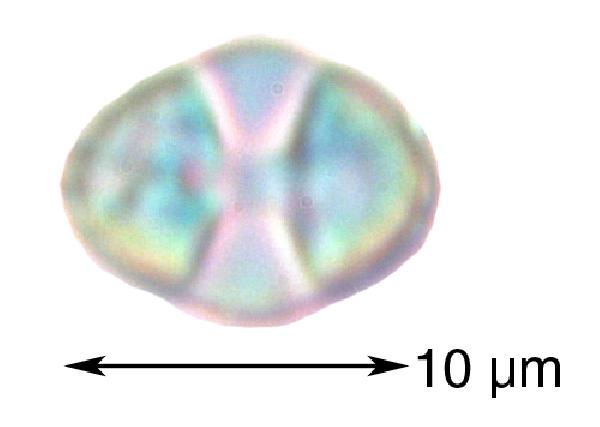

Felix Schumm - CC BY 4.0
[812020], Spanien: Andalucía, Provincia de Almería, coastal strip of the
Llanos de Almería, on fairly protected portions of branches and trunks
of Juniperus phoenica and Pistacia lentiscus between Playa de Cerillos
and Punta del Sabinal, 10-20 m. Leg. G. Follmann, 05.1988, det. G.
Follmann. EX G. FOLLMANN: LICHENES EXSICCATI SELECTI AB INSTITUTO
BOTANICO UNIVERSITATIS COLONIENSIS EDITI NR. 495. - associated
with Dirina ceratoniae and Tornabea scutellifera
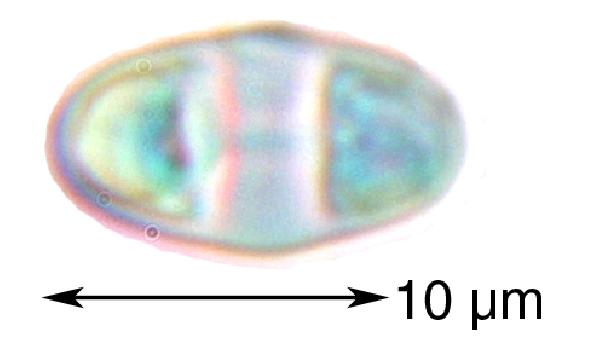

Felix Schumm - CC BY 4.0
[812020], Spanien: Andalucía, Provincia de Almería, coastal strip of the
Llanos de Almería, on fairly protected portions of branches and trunks
of Juniperus phoenica and Pistacia lentiscus between Playa de Cerillos
and Punta del Sabinal, 10-20 m. Leg. G. Follmann, 05.1988, det. G.
Follmann. EX G. FOLLMANN: LICHENES EXSICCATI SELECTI AB INSTITUTO
BOTANICO UNIVERSITATIS COLONIENSIS EDITI NR. 495. - associated
with Dirina ceratoniae and Tornabea scutellifera
Growth form: Fruticose
Substrata: bark
Photobiont: green algae other than Trentepohlia
Reproductive strategy: mainly sexual
Taxon bound to maritime-coastal situations
Commonnes-rarity: (info)
Alpine belt: absent
Subalpine belt: absent
Oromediterranean belt: absent
Montane belt: absent
Submediterranean belt: absent
Padanian area: absent
Humid submediterranean belt: absent
Humid mediterranean belt: extremely rare
Dry mediterranean belt: absent

Predictive model
| Herbarium samples |


P.L. Nimis; Owner: Department of Life Sciences, University of Trieste
Herbarium: TSB (4165)
2001/12/03
detail of hairs on the apothecial margin


P.L. Nimis; Owner: Department of Life Sciences, University of Trieste
Herbarium: TSB (4165)
2001/12/03


Felix Schumm – CC BY-SA 4.0
Image from: F. Schumm (2008) - Flechten Madeiras, der Kanaren und Azoren. Beck, OHG - ISBN: 978-3-00-023700-3

Courtesy Danièle et Olivier Gonnet - Source: https://www.afl-lichenologie.fr/Photos_AFL/Photos_AFL_S/Text_S2/Seirophora_villosa.htm
France, 3/10/2014 - Vers les Ruines de Piantarella bord côtier, alt. 10 m - Corse

Courtesy Danièle et Olivier Gonnet - Source: https://www.afl-lichenologie.fr/Photos_AFL/Photos_AFL_S/Text_S2/Seirophora_villosa.htm
France, 3/10/2014 - Vers les Ruines de Piantarella bord côtier, alt. 10 m - Corse

Jacques Haine - Source: http://www.lichensmaritimes.org/index.php?task=fiche&lichen=1062&lang=en
Spain, Islas Baleares, Mallorca

Jacques Haine - Source: http://www.lichensmaritimes.org/index.php?task=fiche&lichen=1062&lang=en
Spain, Islas Baleares, Mallorca

Jacques Haine - Source: http://www.lichensmaritimes.org/index.php?task=fiche&lichen=1062&lang=en
Spain, Islas Baleares, Mallorca

Jacques Haine - Source: http://www.lichensmaritimes.org/index.php?task=fiche&lichen=1062&lang=en
Spain, Islas Baleares, Mallorca

Jacques Haine - Source: http://www.lichensmaritimes.org/index.php?task=fiche&lichen=1062&lang=en
Spain, Islas Baleares, Mallorca


Juri Nascimbene & Pier Luigi Nimis
Italy, Lazio, Roma, Tenuta Presidenziale di Castelporziano
27.06.2024
on Juniperus and Phillyrea, coastal sand dunes


Juri Nascimbene & Pier Luigi Nimis
Italy, Lazio, Roma, Tenuta Presidenziale di Castelporziano
27.06.2024
on Juniperus and Phillyrea, coastal sand dunes


Felix Schumm - CC BY 4.0
[14326], Spain: Andalucia, Provincia de Almeria, coastal strip of the Llanos de Almería, on fairly protected portions of branches and truncs of Juniperus phoenicea and Pistacia lentiscus L.covering the largely stabilized ridges of higher dunes between Playa de Cerillos and Punta del Sabinal, not rarely asociated with Dirina ceratoniae (avh.) E. M. Fries and Tornabea scutellifera (With.) Laund., 10-20 m, SE-SW exposition, gregaruous, leg. et det. G. Follmann, 05.1988. EX G. FOLLMANN: LICHENES EXSICCATI SELECTI AB INSTITUTO BOTANICO UNIVERSITATIS COLONIENSIS EDITI NR. 495


Felix Schumm - CC BY 4.0
[14326], Spain: Andalucia, Provincia de Almeria, coastal strip of the Llanos de Almería, on fairly protected portions of branches and truncs of Juniperus phoenicea and Pistacia lentiscus L.covering the largely stabilized ridges of higher dunes between Playa de Cerillos and Punta del Sabinal, not rarely asociated with Dirina ceratoniae (avh.) E. M. Fries and Tornabea scutellifera (With.) Laund., 10-20 m, SE-SW exposition, gregaruous, leg. et det. G. Follmann, 05.1988. EX G. FOLLMANN: LICHENES EXSICCATI SELECTI AB INSTITUTO BOTANICO UNIVERSITATIS COLONIENSIS EDITI NR. 495


Felix Schumm - CC BY 4.0
[812020], Spanien: Andalucía, Provincia de Almería, coastal strip of the Llanos de Almería, on fairly protected portions of branches and trunks of Juniperus phoenica and Pistacia lentiscus between Playa de Cerillos and Punta del Sabinal, 10-20 m. Leg. G. Follmann, 05.1988, det. G. Follmann. EX G. FOLLMANN: LICHENES EXSICCATI SELECTI AB INSTITUTO BOTANICO UNIVERSITATIS COLONIENSIS EDITI NR. 495. - associated with Dirina ceratoniae and Tornabea scutellifera


Felix Schumm - CC BY 4.0
[812020], Spanien: Andalucía, Provincia de Almería, coastal strip of the Llanos de Almería, on fairly protected portions of branches and trunks of Juniperus phoenica and Pistacia lentiscus between Playa de Cerillos and Punta del Sabinal, 10-20 m. Leg. G. Follmann, 05.1988, det. G. Follmann. EX G. FOLLMANN: LICHENES EXSICCATI SELECTI AB INSTITUTO BOTANICO UNIVERSITATIS COLONIENSIS EDITI NR. 495. - associated with Dirina ceratoniae and Tornabea scutellifera


Felix Schumm - CC BY 4.0
[812020], Spanien: Andalucía, Provincia de Almería, coastal strip of the Llanos de Almería, on fairly protected portions of branches and trunks of Juniperus phoenica and Pistacia lentiscus between Playa de Cerillos and Punta del Sabinal, 10-20 m. Leg. G. Follmann, 05.1988, det. G. Follmann. EX G. FOLLMANN: LICHENES EXSICCATI SELECTI AB INSTITUTO BOTANICO UNIVERSITATIS COLONIENSIS EDITI NR. 495. - associated with Dirina ceratoniae and Tornabea scutellifera


Felix Schumm - CC BY 4.0
[812020], Spanien: Andalucía, Provincia de Almería, coastal strip of the Llanos de Almería, on fairly protected portions of branches and trunks of Juniperus phoenica and Pistacia lentiscus between Playa de Cerillos and Punta del Sabinal, 10-20 m. Leg. G. Follmann, 05.1988, det. G. Follmann. EX G. FOLLMANN: LICHENES EXSICCATI SELECTI AB INSTITUTO BOTANICO UNIVERSITATIS COLONIENSIS EDITI NR. 495. - associated with Dirina ceratoniae and Tornabea scutellifera


Felix Schumm - CC BY 4.0
[812020], Spanien: Andalucía, Provincia de Almería, coastal strip of the Llanos de Almería, on fairly protected portions of branches and trunks of Juniperus phoenica and Pistacia lentiscus between Playa de Cerillos and Punta del Sabinal, 10-20 m. Leg. G. Follmann, 05.1988, det. G. Follmann. EX G. FOLLMANN: LICHENES EXSICCATI SELECTI AB INSTITUTO BOTANICO UNIVERSITATIS COLONIENSIS EDITI NR. 495. - associated with Dirina ceratoniae and Tornabea scutellifera


Felix Schumm - CC BY 4.0
[812020], Spanien: Andalucía, Provincia de Almería, coastal strip of the Llanos de Almería, on fairly protected portions of branches and trunks of Juniperus phoenica and Pistacia lentiscus between Playa de Cerillos and Punta del Sabinal, 10-20 m. Leg. G. Follmann, 05.1988, det. G. Follmann. EX G. FOLLMANN: LICHENES EXSICCATI SELECTI AB INSTITUTO BOTANICO UNIVERSITATIS COLONIENSIS EDITI NR. 495. - associated with Dirina ceratoniae and Tornabea scutellifera


Felix Schumm - CC BY 4.0
[812020], Spanien: Andalucía, Provincia de Almería, coastal strip of the Llanos de Almería, on fairly protected portions of branches and trunks of Juniperus phoenica and Pistacia lentiscus between Playa de Cerillos and Punta del Sabinal, 10-20 m. Leg. G. Follmann, 05.1988, det. G. Follmann. EX G. FOLLMANN: LICHENES EXSICCATI SELECTI AB INSTITUTO BOTANICO UNIVERSITATIS COLONIENSIS EDITI NR. 495. - associated with Dirina ceratoniae and Tornabea scutellifera


Felix Schumm - CC BY 4.0
[812020], Spanien: Andalucía, Provincia de Almería, coastal strip of the Llanos de Almería, on fairly protected portions of branches and trunks of Juniperus phoenica and Pistacia lentiscus between Playa de Cerillos and Punta del Sabinal, 10-20 m. Leg. G. Follmann, 05.1988, det. G. Follmann. EX G. FOLLMANN: LICHENES EXSICCATI SELECTI AB INSTITUTO BOTANICO UNIVERSITATIS COLONIENSIS EDITI NR. 495. - associated with Dirina ceratoniae and Tornabea scutellifera


Felix Schumm - CC BY 4.0
[812020], Spanien: Andalucía, Provincia de Almería, coastal strip of the Llanos de Almería, on fairly protected portions of branches and trunks of Juniperus phoenica and Pistacia lentiscus between Playa de Cerillos and Punta del Sabinal, 10-20 m. Leg. G. Follmann, 05.1988, det. G. Follmann. EX G. FOLLMANN: LICHENES EXSICCATI SELECTI AB INSTITUTO BOTANICO UNIVERSITATIS COLONIENSIS EDITI NR. 495. - associated with Dirina ceratoniae and Tornabea scutellifera


Felix Schumm - CC BY 4.0
[812020], Spanien: Andalucía, Provincia de Almería, coastal strip of the Llanos de Almería, on fairly protected portions of branches and trunks of Juniperus phoenica and Pistacia lentiscus between Playa de Cerillos and Punta del Sabinal, 10-20 m. Leg. G. Follmann, 05.1988, det. G. Follmann. EX G. FOLLMANN: LICHENES EXSICCATI SELECTI AB INSTITUTO BOTANICO UNIVERSITATIS COLONIENSIS EDITI NR. 495. - associated with Dirina ceratoniae and Tornabea scutellifera


Felix Schumm - CC BY 4.0
[812020], Spanien: Andalucía, Provincia de Almería, coastal strip of the Llanos de Almería, on fairly protected portions of branches and trunks of Juniperus phoenica and Pistacia lentiscus between Playa de Cerillos and Punta del Sabinal, 10-20 m. Leg. G. Follmann, 05.1988, det. G. Follmann. EX G. FOLLMANN: LICHENES EXSICCATI SELECTI AB INSTITUTO BOTANICO UNIVERSITATIS COLONIENSIS EDITI NR. 495. - associated with Dirina ceratoniae and Tornabea scutellifera


Felix Schumm - CC BY 4.0
[812020], Spanien: Andalucía, Provincia de Almería, coastal strip of the Llanos de Almería, on fairly protected portions of branches and trunks of Juniperus phoenica and Pistacia lentiscus between Playa de Cerillos and Punta del Sabinal, 10-20 m. Leg. G. Follmann, 05.1988, det. G. Follmann. EX G. FOLLMANN: LICHENES EXSICCATI SELECTI AB INSTITUTO BOTANICO UNIVERSITATIS COLONIENSIS EDITI NR. 495. - associated with Dirina ceratoniae and Tornabea scutellifera


 INDEX FUNGORUM
INDEX FUNGORUM
 GBIF
GBIF
